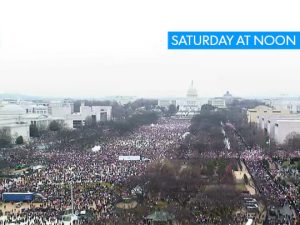Among the most sensational elements of this week’s political news was the debate over the number of people who appeared across an approximately 24 hour window on the National Mall in Washington D.C., the site of both the Trump presidential inauguration and the Women’s March in protest the next day. The controversy started over this particular series of photos, which featured the population attending the inauguration:

and those attending the Women’s March:

As many of us now know, the Trump team was unhappy with this comparison. Those tensions were publicly displayed when White House Press Secretary Sean Spicer provided several plainly erroneous explanations for why Trump’s crowd was smaller, finally reversing his position and claiming that, in fact, “the space was entirely full.” Unfortunately for Spicer, he was proven false with a series of simple photos. The next day, attempting to smooth over the fact that Spicer had lied about the turnout (and several other things) Trump advisor Kellyanne Conway insisted that Spicer had not intentionally attempted to proliferate lies, but “alternative facts.”
This single phrase has, of course, virtually blown up the internet (as the kids say) with its ability to make the Trump camp look bad. As much as I, too, was intrigued by the fact that Spicer would be so bold — if not just stupid — to try to wrangle in facts that most agree are relatively beyond dispute, I was also struck by the fact that the practice of creating “alternative facts” is, to put it bluntly, rather mundane. It is so basic, so humdrum, so much a common part of political — if not simply public — life that, whether we like it or not, it has become the abiding feature of key moments of our politician’s public personas.
In my current book project on political sex scandals, “alternative facts” are simply par for the course. I think immediately of Bill Clinton’s statement that he needed clarification as to what constituted “sexual relations” with Monica Lewinsky before he could answer questions about whether he had behaved inappropriately with her. And we can’t forget Larry Craig’s alleged solicitation of sex from an undercover police officer in an airport bathroom. Craig insisted that his foot traveled from his stall to blatantly and repeatedly touch the foot of the officer in the adjacent stall not because this was the agreed-upon code for his interest in a sex act, but instead, because he simply has a “wide stance” while using the restroom.
Indeed, the very fact that most of us spend time in the classroom talking about “media literacy” and the differences between the various news outlets available to us today is an indication that we already implicitly understood the concept of “alternative facts” before the phrase ever left Conway’s lips. But lest we mark all politicians or media pundits as those whose special brand of facts will single-handedly thwart democracy, let us remember how commonly we, ourselves, gamble in this same sort of language. Anyone who’s ever dodged the sex-talk of the birds and the bees with a conversation about a stork has indulged in some alternative fact-production.
So what is perhaps all the more intriguing about “alternative facts” is not that they exist, but our failure to locate their ubiquity. That’s not to say that we might not ethically question them, nor ask why Spicer was ever permitted to enter the fact-production ring, for he clearly is no master. But I wonder if our interest in highlighting these moments of spin — no matter from whom they emanate — has more to do with our desire to uphold the fiction that there is a real and stable objectivity that we can find if we merely search hard enough. There’s no doubt that Spicer’s statement was ridiculous. But inasmuch as he played the fool, what he also provided many of us was the reassurance of an epistemological security that we might need to draw on when the numbers — or in the case, the photos — aren’t quite so clear.
photo credits: http://www.usatoday.com/story/news/politics/onpolitics/2017/01/21/womens-march-on-washington-crowd-photos/96882758/
